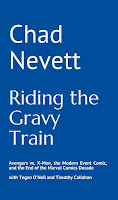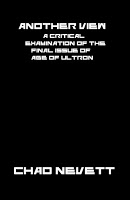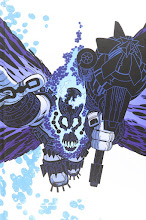[
The sixth of seven posts on Frank Miller's Sin City
as part of a larger, cross-blog thing. David Brothers has the index over at 4thletter. Go read anything you missed.]
 Booze, Broads, & Bullets
Booze, Broads, & Bullets is a collection of various
Sin City shorts and I'll take them one at a time in the order presented in the book. All by Frank Miller, obviously.
"Just Another Saturday Night" (1997). Marv killing some frat boys who he discovers beating up a homeless man for fun on the same night that Hartigan and Nancy meet in
That Yellow Bastard. I haven't talked about it yet, but now is as good as time as any, but Miller is pretty... not obsessive, but... sure, let's say obsessive about telling us how stories fit together, throwing in little background scenes of characters interacting. "Blue Eyes," for example, shows an unseen scene between Shellie and Gail during
A Dame to Kill For. It's interesting, but grows a little tedious after a while. Maybe that's because I don't care. What does it matter that Marv had this little adventure on the same night as Hartigan's shit with Junior? It doesn't. It's not a distraction, but it's unnecessary. More than that, Miller also likes to fill up background scenes with small pieces of dialogue... which works sometimes and not others. Some pages get too busy. I find he's at his best when he keeps it simple and focused, which those pages get away from.
But, getting to the actual story here. It's not a favourite of mine. The art is similar looking to that used in
Family Values with less contrast, more lines, a little rougher, sketchier, uglier than always... but also with more panels per page. This story feels cramped, like it needed more room. Not the 120-plus pages of
Family Values, but more than the 17 it gets. One thing that Miller does that's interesting is having Marv tell us the story from after it happened, often giving us panels of Marv's head in the background or pushed to one size of a panel, showing us that he's narrating.
"Fat Man and Little Boy" (1996). A three-page story that focuses on Douglas Klump and Burt Shlubb, the eponymous Fat Man and Little Boy that have appeared in
That Yellow Bastard and
Family Values as well as "The Babe Wore Red," which is the last story in this volume. Klump is Little Boy, while Shlubb is Fat Man. You can probably guess what they look like by their names. In this story, they just have to dispose of a body off the docks. It's rolled up in a carpet, but these nice boots are sticking out. They have a problem with deviating from their intstructions and doing stuff like stealing the wrong cars for jobs -- so, when they take the boots off to steal them, they discover that there's no body and the whole thing blows up. They've been punished for their greed and not following orders. A cute little story. Shlubb and Klump are entertaining since Miller writes them as these two lowlifes that use a lot of fancy words. It can get grating, but it makes them stand out and works in small doses like this. The story is only seven panels long, so Miller doesn't really do anything fancy with the art.
"The Customer is Always Right" (1994). A story that I like more each time. Only three pages, it's a little piece of flash fiction. Poetic and brief, haunting and alluding. Describing the plot doesn't really tell you why it's good. Basically, this is our introduction to the Colonel, an assassin (who, in
Hell and Back is shown having interests beyond that) that kills a woman here, apparently at her request. It's soft and sweet. I really dig Miller's narration, which isn't that divorced from his standard poetic language when a man talks about a woman in one of his stories, but being limited here helps. Being vague and allusive works with the story. The art is entirely contrasts. No real outlines, characters existing half in light, half in shadows, lots of suggestion of form. It's raining for added mood. This is the story that Robert Rodriguez filmed to demonstrate the green screen technology to Miller to prove he could do
Sin City and it begins the film. I like it better on the page with Miller's implied figures and extreme contrasts.
"Silent Night" (1995). A 26-page story told almost exclusively in splash pages and containing only one word balloon. The plot is simple: Marv goes to a place where a little girl is being kept, presumably so people can come and have sex with her -- or purchase her outright. So, Marv kills those responsible and takes her home. The story takes place on a snowy winter night, which means we get Frank Miller snow, which is the best snow you'll ever see in comics. It's wet, clumpy, heavy snow that just litters the page. You don't so much as see the snow as feel it -- at least if you've been in this sort of snow. The first page is just the snow, while the second and third have Marv walking towards us in the snow. Gorgeous pages. The fifth page gives us a full-page shot of Marv looking at us and it's probably the most 'human' image of Marv we've ever gotten. He doesn't look like Marv per se, but he doesn't not look like Marv. It's almost an attempt at drawing him in a more realistic manner, but still with big contrasts, lots of weird black and white lines. He doesn't look happy. The little girl, Kimberly, is drawn in a way that prefigures Nancy in
That Yellow Bastard. There's a fun gag with two of the criminals being these twin balding fat goofs with big noses, sunglasses and striped shirts. Every page is a splash except for one page with two panels and another with three. Those pages move the story along as Marv descends into the basement of this building. Wonderful page after Marv has seen the girl of this bright white with minimal black -- Marv's internal rage before he kills the fuckers.
"And Behind Door Number Three..." (1994). A four-page story about Gail and Wendy capturing a rapist/murderer that ends with them about to torture him. Really simple, notable for the art, which has Miller really pushing his use of negative space to suggest forms and shapes. In the first panel, Wendy's head is a white shape that simply blocks out the background. He also does a nice trick with three of the pages containing the same perspective and having one of the women enter. First Wendy, then Gail, then Miho. Nice repetition of the image.
"Blue Eyes" (1996). The introduction of Delia, the eponymous Blue Eyes, who has blue eyes and always wears blue clothing. One of the rare characters to get colour in
Sin City, it would hardly work without the colour. Jim is being followed by the Colonel for no reason that he can think of, unaware even who the Colonel is. But, it's driving him crazy, so he steals a car to escape him, winding up at Kadie's -- but the Colonel shows up there, too! Just as he turns to leave, there's Delia, an old flame that's in trouble and he's more than happy to get back with her and help. After having sex, she kills him, revealing that she married a bad guy who she killed, discovering she has a talent for it and enjoys it, and killing the man she really loves is her initiation into a guild of assassins. At the end, the Colonel comes in, says that crying is okay and part of the process, and that she needs a codename -- she says to call her Blue Eyes. There's a great trick where the first half of the story lives inside Jim's head via thought balloons, but when Delia shows up, the thought balloons disappear and Marv gets some. Delia arrives and Jim stops thinking, he just reacts, never questioning the coincidence that he's being followed and Delia arrives at the same time.
There's something disturbing about Delia. The colouring of her eyes is so bright that they seem bigger (maybe they are bigger), giving her an odd look. The blue clothes really make her stand out. It's an interesting decision to colour not just her eyes blue, but her clothes as well. There's a bit of the sketchy heavier lined look in the art here, but it's much more focused on contrasts -- contrasts that grow to heighten the tension that then slowly disappear once Jim is with Delia. The emotion post-sex when Delia realises that she really loves Jim, more than she thought she did, is great.
"Rats" (1996). An odd story that's divorced from every other
Sin City story. It's about a former Nazi living in Basin City in a shitty apartment. He gases rats in his stove until a man comes in and sticks the Nazi's head in the oven to gas him. Pretty clear on what the point of it is. One thing I've always liked about this story is the way that the narration is presented: large typewriter-esque captions with every word seemingly cut out of a typewritten page and just pasted on the art. Gives it a different feel. The text is larger and dominating. The Nazi eats dog food. Lots of contrasts in panels. The man that kills the Nazi is a large, balding man with glasses. I don't believe we've seen him anywhere else. Wikipedia says that some call him the Janitor for whatever reason.
"Daddy's Little Girl" (1996). No connection to other
Sin City stories, but in total faux-noir vein and storytelling. Miller uses pink colouring for Amy, the woman here that gets Johnny, our narrator, to go and kill her father so she can inherit his money and they can be together. It has him agonising over the decision, eventually approaching the old man and, first, asking for Amy's hand in marriage, but, when rebuffed, he shoots the father. Except it was blanks in the gun and it's all part of a sick incestuous game Amy and her father play where this is the only way to get him excited. The pink colouring gives Amy that sweet, soft look that makes her betrayal a little more sicker and twisted. Johnny looks a bit scummy, a little too old for Amy himself. Miller uses a mix of extreme contrasts and regular detailed shots. One panel of the father standing in front of a giant window in his mansion, us looking in from an upper angle is great. Fantastic lighting and shadow.
"Wrong Turn" (1997). A 23-page story about Delia that's really relaxed with lots of splashes and heavy use of blacks. The story begins with a man almost hitting Delia, who is lying on the road in the rain. He swerves to miss her, gets out, helps her out by giving her a ride after he car has broken down. She wants him to take her to the Pits and he obliges her, reflecting on the fact that he's married, but he had a fight with his wife. There's a slow seduction as Delia, in tight wet clothes, tells him about her first time, which was with a guy there and, just before sex, he stops her to tell her he's married. She wonders aloud why he'd lie about his name, but then come clean about having a wife. Turns out she was supposed to kill another guy in a similar car that was supposed to be coming down that road then -- he got a flat tire. She kills him and the Colonel is there to tell her that it was an honest mistake and that this guy wasn't so innocent as his wife's body is in his trunk. The story ends with Delia going to go kill the intended target on a train. The series of splashes of Delia in the rain are gorgeous. Lots of shadows mixed with white lines for rain, blue clothes sticking to her... and, then, the make-out/pre-sex pages are done without panel borders, just blending into one another. A really good-looking story. Lots of the sketchy ugly art of Miller's, but it works well here.
"Wrong Track" (1997). A three-page sequel to "Wrong Turn" where Delia kills the intended target after having sex with him on the train. The Colonel asks her at the end if she's going to have sex with every target and she says only the ones she likes. The opening splash of the train in the tunnel is great. A winding, curved look with lots of bricks.
"The Babe Wore Red" (1994). The last story in this collection, it was the main story from the first
Sin City comic to contain short stories (along with "The Customer is Always Right" and "And Behind Door Number Three...") and the first to use colour. Miller has said that he used the red for the woman's dress, because he wanted to highlight her curves. Which the red does. This is a Dwight story as he comes when a friend calls for help only to find his friend strung up on a ceiling fan by piano wire. He finds a body with its head in the toilet and Fat Man Shlubb behind the door -- the first appearance of the duo, I believe as Klump shows up later in the story. After laying him out, he discovers the babe in red in the shower. Someone takes a shot through the window and they leg it. Klump (the shooter) and Shlubb follow to the Farm where Dwight takes them out and discovers what's what. His buddy was helping a PI (the body) and the girl just got mixed up at the wrong time, nervous about her wedding the next day -- the punchline being that she took her vows the next day to become a nun. A decent little story with an unexpected twist. Even rereading it, I kept waiting for her to betray Dwight, but Miller doesn't go there. Miller's art here is some of his weakest. Very clunky and messy... in that characters don't look right. It looks dashed off in a bad way. Maybe he was trying out some things, but they didn't work. I love the use of red, but Dwight looks weird. Some panels, of course, are fantastic, but, overall, some really sloppy work.
Booze, Broads, & Bullets is a solid collection. None of the stories are fantastic, but there are some really nice bits here. Oddly, this would probably be the last
Sin City book I'd recommend. Normally, short story collections are great (at least in the prose world), because you get to see an artist's range and get a lot of material in the same sized package. Something you can jump around in. It seems like Miller used his short stories as ways to try out things, see what art techniques worked, what characters caught his fancy, sometimes just have a bit of a laugh. Nothing wrong with that and I'm not disappointed with the book at all, it's just that a lot of what works works because of its context as book six in the series. Of seeing how these stories fed the longer narratives. Of how they add little character bits to the leads from the other books.
Tomorrow, Frank Miller Week concludes with
Hell and Back, the longest
Sin City story.
 I recently reviewed Ultimate Comics Avengers 2 #1 for CBR and, in the process, wrote the following sentences: "Only one week after the conclusion of the first volume of Ultimate Comics Avengers, the beginning of the second ships. Unlike the first volume where the threat was readily apparent with the team of Nick Fury’s Avengers already in place, this story begins with a focus on teambuilding without a known enemy -- or, at least, not one that we’re told about. The first new recruit of Fury’s Avengers: Frank Castle, the Punisher."
I recently reviewed Ultimate Comics Avengers 2 #1 for CBR and, in the process, wrote the following sentences: "Only one week after the conclusion of the first volume of Ultimate Comics Avengers, the beginning of the second ships. Unlike the first volume where the threat was readily apparent with the team of Nick Fury’s Avengers already in place, this story begins with a focus on teambuilding without a known enemy -- or, at least, not one that we’re told about. The first new recruit of Fury’s Avengers: Frank Castle, the Punisher."




























